
I first blogged about this matter in March 2009 and then again in 2014. This is now the fifth update as Public Health Scotland have updated their guidance in March 2024. It is now called Health Protection in Children and Young People Settings, including Education. This post is mainly aimed at those who work with younger children but the advice can be adapted accordingly for any age and the new guidance is also clear that schools are now included. There is also specific guidance on toileting and sanitation and ‘outdoor learning, forest schools and educational visits’. If you are based in other UK countries then similar guidance is available: Health protection in children and young people settings, including education.
There’s two elements to this post. Firstly there is ‘temporary toileting’ which covers advice when out and about. The second is when a site is well used and there are no public toilets or installed flush water toilets nearby.
As usual, common sense prevails along with available guidelines when it comes to toileting outdoors:
- If you can use a public convenience then do so.
- Put in place an environmentally sustainable and Leave No Trace approach.
- Be mindful of the need to respect children’s privacy and dignity, and that of adults.
- Ensure your procedures follow best hygiene and infection control practice as much as possible.
Is there a “best approach”?
When discussing the matter with staff working in outdoor nurseries and forest kindergartens, I found quite a number of approaches are taken to toileting outdoors. This is because different situations require different ways of thinking. There is no one-size-fits-all approach.
Generally, children are encouraged to go to the toilet before setting off or arriving on-site. Getting in and out of dungarees, all-in-one-suits and other outdoor gear is a faff, so children tend not to need the toilet as much outside. Some kindergartens create a little privy area behind a home-made fence or portable windbreak. Some choose key moments through the day, where every child goes to the toilet. I would strongly discourage the latter approach in that this has the potential to disrupt play and for a child who can independently manage their toileting, it seems unnecessary.

Wild Toileting
When a site does not have toilet facilities or if you are too far away from public conveniences, it is important to follow the Scottish Access Code guidelines if you go to the toilet outside:
- If anyone needs a pee, then this must be done at least 30m from open water, rivers or streams.
- Although pee is less harmful than poo, its smell is unpleasant, so avoid peeing in caves, at the foot of crags or behind any buildings. Also encourage children (especially boys) to aim onto the ground. Remember to avoid peeing on logs or directly onto a “pee tree”.
- If anyone needs a poo, then go as far away as possible from buildings, from open water, rivers and streams, and from any farm animals. Remove the human poo and used toilet paper, in a double wrapped, sealed, biodegradable plastic bag and dispose of it off site, following your local authority guidelines for biological agents. This is the best approach in that it leaves no trace. If you are unable to remove the poo and paper, then you will first need to dig a shallow hole. Bury the poo in the hole and replace the turf. Carry a trowel with you for this purpose. Be aware that this really is an emergency approach. Pathogens can hang around in the soil for a very long time.
- Always treat sanitary towels and tampons in line with disposing of other blood-soiled products. Never bury these items. Double wrap in sealed plastic bags and take back to school or nursery for correct disposal.
- Wash your hands, following good hand hygiene practices. Have a look at this blog post for the variety of ways and things to consider.
The Mountaineering Council of Scotland has a handy leaflet which explains other procedures more specifically, in order to minimise the impact of one’s visit. This is important reading for all who lead off-site visits. It also gives sensible advice about sustainable approaches such as using cornstarch or biobags and the need to use biodegradable soap. Do be aware that some of its hand hygiene advice differs to that of Public Health Scotland (PHS) and that schools and nurseries are should follow PHS advice in the first instance.
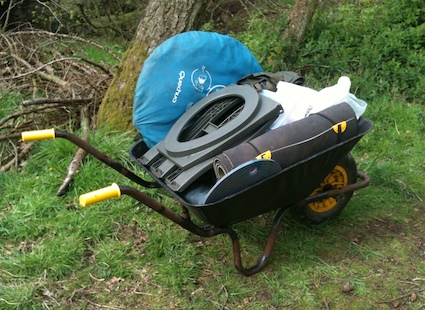
When using the same site continuously
In sites with higher usage then a wild toileting approach is not okay as the soil will not cope with large amounts of ammonia contained in the urine (interestingly, a well-managed compost heap does like urine, so bear this in mind). This is important if your setting or school is using the same site on a continuous basis. Discuss your proposals with a local environmental health officer. Public safety is of paramount importance and avoiding inadvertent contact with pathogenic material or the leaching of this into the wider area.
Portable potty and toileting approaches
In some instances, it may be appropriate to use a travel potty or portable toilet and then to dispose of the contents in line with your establishment’s procedures for handling biological waste back at your centre. What does matter is that the approach leaves no trace, is hygienic and any product used is environmentally sustainable. With the increased popularity of festivals portable toilets of all types can be found with an online search. Be aware that children and adults sit at different heights so do not assume they can share a toilet.
Try googling “travel potty”. This approach is fine if you have the occasional toddler needing an occasional poo. However, at an outdoor nursery, you may well get a lot of children needing to do this. Very quickly the “bag-it-up” approach becomes expensive and unsustainable in every way.
In due course, it may be that self-sanitising biodegradable options will become available in the UK . There are products in some majority world countries which is being used in a variety of countries and in their schools where no sanitation facilities exist.
Little girls and wild peeing
There has been a tradition of lifting little girls up to let them pee so that they don’t get their outdoor clothing wet. This is not recommended, either for the dignity of the child or for the unnecessary manual handling undertaken by the staff member. Instead, a potette potty, or similar, can be put over a cleared patch of soil so that girls can sit on this and pee directly into the ground, without the need for a bag. Just remember to put back the woodland litter at the end of the session.
Disposal of human waste: nappies and bags of poo
It is inadvisable to put nappies and bags of poo into public litter bins as a responsible childcare provider or educator. It is your responsibility to take them back to the nursery and dispose of them as per nappies and other human waste. If you do not have these facilities then you need to seek a place that has and come to an agreement over the costs of disposal. Furthermore you need to follow your local and national guidance. For example, in Scotland, SEPA and the Care Inspectorate have produced this guidance. You need to follow the steps to work out what to do for your precise situation – and again, your local environmental health officer is best consulted. Be aware that used tampons and sanitary pads are considered in a different category to poo. They contain blood and bodily fluids that can contain germs that cause infection. Therefore plan for adults and older children (from 9 years upwards).
There is an urban myth that it is okay to put nappies and bags of poo into doo poo bins. Again, this practice is questionable because the disposal of the contents of dog bins varies from council to council. Furthermore, dog poo bins are small. If you are putting a large bag in there, then there’s less space for dog mess.
Chemical toilets
Some fixed outdoor nursery sites choose to use chemical toilets. It does mean the toilets need emptied on a weekly rather than daily basis. Many chemical approaches are becoming more environmentally friendly so it’s worth finding out what products are available.
Regardless, someone will need to carry the toilets out and dispose of the contents. This will involve manual handling of the waste. Or this will have to be a paid-for service. It’s worth asking a local campsite if they can offer to take the waste as they usually have the correct facilities for managing camper van toilets. At Oban Stramash to empty five or six toilets in this way involves one member of staff working for 1 to 1.5 hours. So this time needs to be factored in the weekly or fortnightly routines.
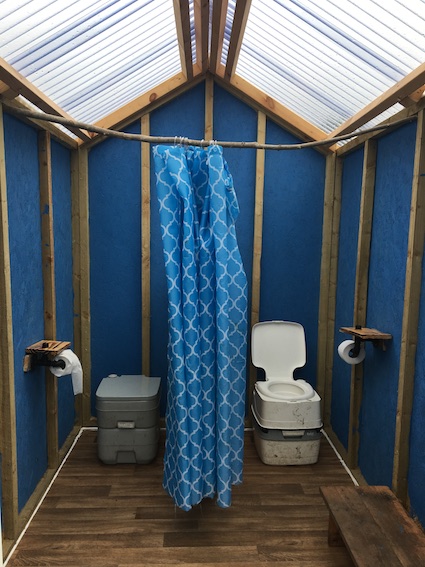
Hiring outdoor toilets
This can be an option for primary schools where children can cope with the height of the toilets. Do an online search to find out about local companies that can do this, precisely what is involved in the service, length of contract and any hidden costs. Be prepared to ask about environmentally friendly chemicals, whether the toilet is suitable for the age and amount of use you expect. Examples (but not recommendations) include this company and this one and this one. Check about suitable places to site a toilet and footfall around the entrance. You need to avoid an inadvertent mud bath at the toilet so ground surface matters. You may also wish to double check about infection control measures that are possible such as social distancing, individual cubicles, type of hand washing facility and so on.
Child protection and toileting outside with dignity
Child protection procedures always apply outdoors. If you have to change nappies, children clothes or assist with toileting, follow your school or local authority procedures. It means that a degree of privacy is needed.
In Sweden there is a proverb, “Walk seven bushes”. Now this is very sensible advice. Try it for yourself the next time you are in a wood. It’s just about the right distance to give you a suitable amount of privacy.

However, this is not so easy when working at open sites such as fields, the beach or walking in a built up urban area.
When walking down an urban street where there is no discrete place, using a human shield is an effective approach to maintaining a child’s dignity. This is where the group gathers round in a circle or semi-circle facing outwards and the child who needs the toilet is sheltered from vision by the group and supported by a member of staff.
With beach visits, try experimenting with shelters such as the traditional wind break, pop up shelters and bothy shelters. However these can be time consuming to erect especially on windy or cold days. Watch out for pop up tents – you need one without a floor. A simple tripod is quick to erect if you are willing to bring long poles, e.g. 120cm or longer for children. Alternatively human shields can used if there is no rock, nook or cranny to nip behind or simply too many other visitors around.
Finally, in our digital age, having protocols around technology that enables photographs or other recordings to be made need to be considered. Is there a place such as a hook, holder, etc where staff who are supporting a child can safely leave their digital gear including watches that take photos? This could be as simple as a dry bag that is hung up outside the “cubicle.” Is there a place for hand washing prior to using the digital device after toileting?
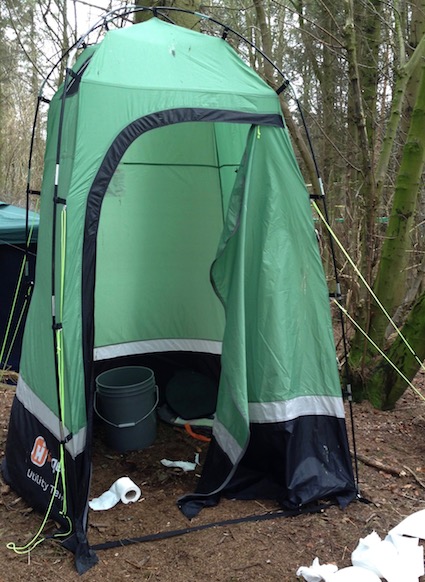
How do you keep the toilet roll dry?
This is a good point. Wet loo roll is not good. A low cost approach is to take a toilet roll and remove the inside cardboard tube. Pull out some of the sheets from the inside hole you have left. Put the roll in a freezer bag and ensure the sheets coming from the inner hole come out of the top of the freezer bag. Loosely tie an elastic band around the top of the freezer bag and sheets of toilet paper. When you continue to pull the toilet paper it should easily come out of the bag.
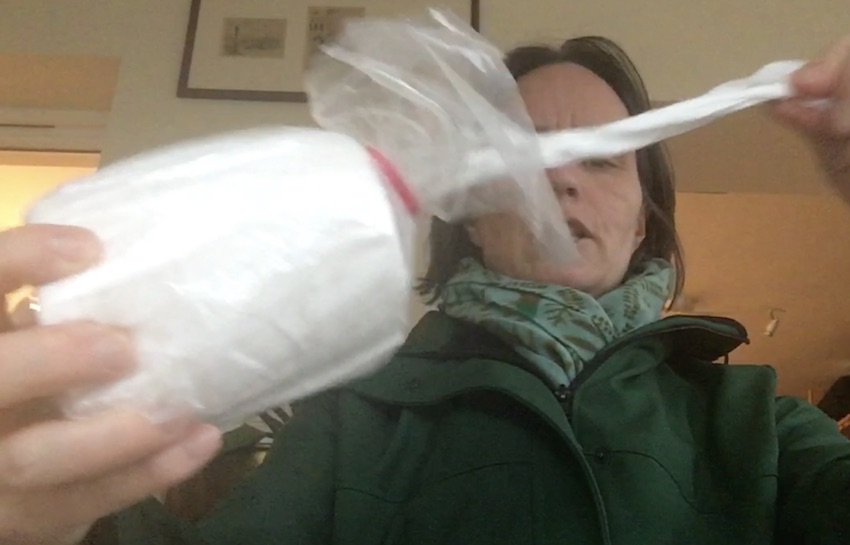
What about adults accompanying children?
Remember to have procedures in place for enabling adults to go to the toilet. For example, some settings prefer adults to go in pairs, so that one can lookout for the other and ensure children do not accidentally come across an adult going to the toilet in the woods.
It has to be emphasised that some adults may need support and time to adjust to the concept of wild toileting or managing with more basic provision. Listen to their concerns and look for positive solutions. For example, having a designated space further away, a system for quietly being able to go, a way of managing sanitary needs, and even a portable seat can all make a difference to comfort levels and dignity. Portable seats are easy to find, such as these examples from Muddy Faces, Popaloo and Bog in a Bag.
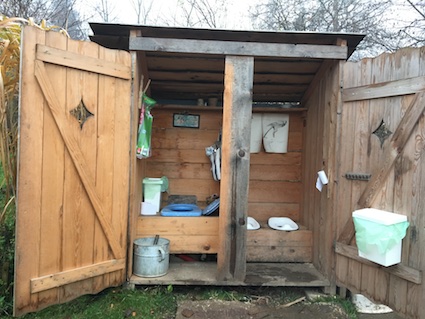
How can we change children’s nappies?
As much as possible, nurseries should be encouraging children to learn how to go to the toilet off-site too. Putting children back into nappies for the purposes of going off-site is probably not a helpful step forward. Instead have procedures in place for supporting children who are being toilet trained and take changes of clothes just in case an accident happens. For example, wearing waterproof trousers rather than dungarees or all-in-ones can speed up the process of toileting when time is of essence!
For emergency nappy changing, pop-up shelters or pods can be handy, as can be a roll up changing mat for nomadic nurseries or if you visit a woodland on a weekly basis, particularly with babies. Standing up nappy changing is also an option to consider. If you are based in Scotland and a registered provider, you need to take account of the Care Inspectorate guidance: Nappy changing for early learning and childcare settings (excluding childminders). Thus if you are an outdoor nursery with a static site, you need to check that your provision passes muster.
Whatever your method, ensure you discuss this both with the parent and the child so that everyone is informed and aware. Likewise, you need to ensure the privacy and dignity of the child and that the experience is okay for them. Your hygiene practices should also dovetail with Public Health Scotland (PHS) guidance which now has a specific section on toileting and sanitation. Some of your children may have very specific needs.
Here is a video of other examples of nappy changing in Scottish outdoor nurseries:
Compost toilets
Over the past few years, there has been a growing interest in using compost toilets which can be a sustainable solution. A useful starting point for finding out more about these is the Eco Loo Study, published in 2010, which states that:
“Water flush toilets are the standard offering that the public finds most comfortable, that contractors and regulatory authorities understand, and know how to manage. This standard then needs to be balanced with the needs of the natural environment: water-based toilets pollute large volumes of clean water which then need to be cleansed before being returned to nature. The nutrients that remain in faeces are wasted and typically released into the atmosphere as greenhouse gases that may also be malodorous.
The design of sustainable toilets and drainage should ensure that waste and wastewater is recovered, treated or disposed of without endangering human health or harming the environment, and in particular without risk to water, air, soils, plants or animals. Toilets should not cause a nuisance through noise or odours and toilet buildings should integrate sympathetically with their surroundings.” p6
Always discuss toileting approaches with the site owner or manager so that you both have a shared agreement and understanding of the procedures which are used. Again, you will need to involve your local environmental health officer. In addition, you may find you need planning permission, and have to consult SEPA (Scottish Environmental Protection Agency) who may need to approve the discharges.
You have to be aware that compost toilets are significantly more work to manage and maintain than installed water flush toilets. This should be factored into the site maintenance schedules. When working well, they can be a brilliant solution to managing waste onsite and the smell is minimal, if the compost toilet system is functioning properly. There are lots of different designs and approaches. You will need to do a lot of homework to ensure you fully understand what you need. What works well on one site, may not suit another. It depends on anticipated usage and site specific environmental factors. You need to consider how the waste will be processed and who will do this task as this element is often missed from the “oh, it’s so easy” blurb found on many websites. The Eco Loo study makes a very significant comment:
We take the position that commercially-available ‘composting toilets’ do not work well at typical U.K. temperatures, and very little composting occurs. The storage vessels act primarily as holding tanks and therefore provision must be made for further processing of the accumulating solids. If there is no outlet on a composting unit, allowing liquid to drain, the vessel risks turning into a cesspool [G], which is illegal in Scotland. (p18)
One crux matter is to know how well used your compost toilets are likely to be. Occasional use by a group of ten children is very different to an all-day nursery with 30+ children. Some companies (and this one) are beginning to provide better information on their website and are worth talking to in advance.
When in the Czech Republic, one NGO that specialised in composting, had a sensible system that followed this approach. Firstly, the collection bin was not too big. The accumulating solids would be transferred every 3-4 months to a sealed composting unit nearby for further breakdown. From here, the waste matter was left to further break down in an outdoor compost heap. This contained only human waste matter (with the sawdust/wood shavings). Other traditional compost heaps were used for vegetable waste. Once it had broken down over a further few months, the compost was used. In line with best practice, the human waste compost was not put under trees, shrubs or on plots that were growing food for human consumption. In this sort of system, it is important to ensure children and visitors cannot access the human waste compost during any stage of the breakdown. PPE must be worn by the person who is working with the compost and a risk assessment carried out.
One thing to remember is that nursery-aged children are a lot smaller than adults. Using a standard compost toilet seat will not work. They need child-sized seats such as the Separatt Child Seat (from this website). Another consideration is the understanding of how much sawdust or equivalent needs to be added. There’s a tendency to over add, especially if your toilet is already smelly – which may not be a good sign.
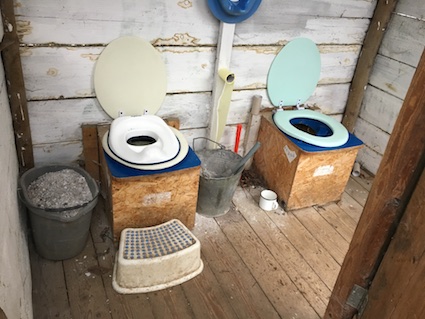
Other alternatives
There are other ways of managing human waste. As with other approaches, engaging with environmental health officers, SEPA and anyone else who needs to know is a must. World-wide pit latrines are common but I have yet to know of one that is accepted and used within an outdoor nursery. Highway Farm have a remote pit method which was established in consultation with their local environmental health officer. It involves daily removal of poo and pee from the toilets into a fenced off area. Fresh pits are dug every few months and the filled up gradually with the turf replaced daily. The nursery is onto it’s second rotation now, after several years, so the holes are much easier to dig and the previous matter has been fully composted but is left in situ. If you have a site that is prone to flooding or getting very wet then this may not work and a raised system used.
Finally…
In my experience, toileting routines are a big concern prior to setting up regular off-site visits or outdoor nurseries but once things are up and running, this matter lessens and usually becomes no more of an issue than back at nursery or school. If you have a child who has particular toileting needs, then ensuring their parent or carer is involved in setting up systems can be helpful too so that there is consistency between home, school and the outdoor space. Stramash Outdoor Nurseries have a great range of policies which include several around toileting which you may find reassuring.

Whilst this is a lot of toilet talk, your advice and thoughts are appreciated on this matter! Do you live outwith the UK? What advice can you give from your country?
A lovely example of approaches taken in Scottish outdoor nurseries can be seen in this video:
Note: This blog post is written in good faith and should not be used as a definitive guide to toileting outside. It’s a complex matter. Always seek expert advice.
This blog post was most recently updated in March 2024.




















Great tips Juliet, still struggling with this one myself, trying to find the best solution.
Hi Kierna
I think the nurseries where children are going off-site on a weekly or more often basis tend to find solutions experientially. The Secret Garden Outdoor Nursery has certainly done this over the years. So much depends on the children you have in your class and what they can manage.
Mine are older now but it is easier for my son to pee discretely than for my daughter, it’s hard when you spend lots of time outdoors
Agreed – I think there is a gender difference. It’s also why I think many settings do take a potty – so that young child have something familiar and that can be reassuring.
This is a very very helpful info to me. We are keen in camping and these is important. My son always wee outside and we aim it on plants and trees. Now I know we should aim to the ground. Thanks for sharing =) #countrykids
Great article thanks! In D and G in Scotland, I was advised that I could put nappy bags directly into bins for collection. For our outdoor ed, we have an outdoor portable toilet and I used a bag and sawdust which I then threw in the bin. I’m now wondering if this is not the best approach. Also has anyone found that especially boys love the novelty of pooing when they probably could have waited until getting back? Increase in need to poo has definitely increased since the pop-up tent appeared!
Catherine – this is a brilliant comment! Thank you. Yes, some local authorities do not seem to mind nappy bags going into dog poo bins… but this is not standard across the board.
Yes re poos… both girls and boys. Earlier on this year, I was working with a group and the first couple of weeks were full on as children went to the toilet lots. It then calmed down… phew!
Also in outdoor nurseries, children end up going to the toilet much more normally… as one friend said “I have 32 children in my nurseries and that’s a lot of poo to deal with during the course of the day!” Hence the need to be mindful of precisely what outdoor provision one is offering!
Some great tips here. We used the shallow hole approach on our forest schools site but as we were only out with the kids for a couple of hours at a time it was rarely used. Thanks for sharing at the Outdoor Play Party 🙂
An oldie but a goodie! We now have a shed with a camping toilet in situ for use when up in Bear Woods and so far it is working perfectly.
Thanks Kierna – Please that you have found a solution!
Hi Juliet,
Thanks for your thoughts on this topic! Your link to the 2010 Eco Loo Study doesn’t seem to work any more – would you mind sharing again?
Thanks
Jane
Thanks for letting me know Jane. I’ve mended the link so hopefully it works now.
Great article-thanks. Can you tell me more about how to use the cornstarch? We have a loo tent, folding plastic loo, plastic bag with one scoop of commercial product. Can the cornstarch replace this commercial prouct? Thanks
Hello Helen
Thanks for your query – I think it’s a typo error – the cornstarch refers to the material biodegradable bags are made from. So no, cornstarch won’t replace a commercial product – but I’m sure there’s alternatives out there. For example, the use of pine needles is common for compost toilets.
Hi Admin
Thanks for this useful information, for more please visit:
Best Camping Toilet UK
https://www.interneteyes.co.uk/best-camping-toilet-uk/
Thanks Nicholas
NOTE TO READERS: This is list does contain many of the common examples highlighted in the blog post – remember you can order from many different places and new types of toilet seem to appear on the market fairly regularly!
Hello Juliet, Thanks for sharing this article, I also share Camping Toilet-related article here
Best Camping Toilet UK
https://www.interneteyes.co.uk/best-camping-toilet-uk/
Hi,
I would definitely recommend the Tree Bog design. We’ve used one here at our far NW outdoor venue for 20 years, 2 chambers, minimal management, super compost (each chamber emptied every couple of years only).
https://www.sustainability-centre.org/tree-bog.html
Thanks Em – feedback over what works is always helpful. It’s also good to know the context. So this article is aimed at those who work with children, for example, at an outdoor nursery or a school site. So usage rates need to be factored in (for example, casual use is very different to 40 children full time on a site), alongside the need for modifications for both the way children pee and also accessibility to the toilet. So steps are great most of the time, but most sites for children may need an accessible toilet too. There’s always a lot to consider, isn’t there!